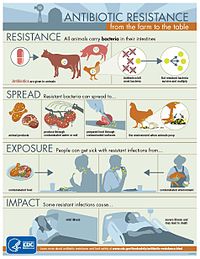
Photo from wikipedia
Simple Summary Bovine Mycoplasma species, particularly antimicrobial resistant Mycoplasma bovis are important causes of bovine respiratory disease (BRD) in cattle, which causes major economic losses worldwide. Thus, the current study… Click to show full abstract
Simple Summary Bovine Mycoplasma species, particularly antimicrobial resistant Mycoplasma bovis are important causes of bovine respiratory disease (BRD) in cattle, which causes major economic losses worldwide. Thus, the current study aimed to determine the prevalence and antimicrobial resistance profiles of bovine Mycoplasma spp. isolated from cattle’s respiratory tracts, in addition to evaluating the fluoroquinolone resistance in the recovered isolates using broth microdilution and conventional PCR techniques in Egypt. Our result showed that M. bovis was the most common spp. (61%), followed by M. bovirhinis (15%). In total, mycoplasma isolates were more prevalent among all examined lung tissues (38%), followed by nasal swabs (35%), tracheal tissues (28%), and tracheal swabs (27%). All the examined mycoplasma isolates (n = 76) were 100% susceptible to spectinomycin, tulathromycin, spiramycin, and tylosin, but high doxycycline and enrofloxacin minimum inhibitory concentrations (MICs) values were observed among 43.4% and 60.5% of the tested isolates, respectively. Three and two mycoplasma isolates with high enrofloxacin MICs were confirmed to be M. bovis and M. bovirhinis, respectively, by PCR assays. All molecularly confirmed mycoplasma isolates (n = 5) were positive for the gyrA gene (100%), meanwhile, three isolates (60%) were positive for the parC gene. In conclusion, understanding antimicrobial resistance mechanisms is a significant tool for the future development of genetic-based diagnostic techniques for the rapid detection of resistant mycoplasma strains. Abstract Among many bovine Mycoplasma species (spp.), Mycoplasma bovis is recognized as a significant causative agent of respiratory diseases in cattle. In recent years, resistant M. bovis isolates, especially to fluoroquinolones, have been reported globally as a result of the extensive usage of antimicrobials in the treatment of bovine pneumonia. Therefore, the aim of this study is to investigate the prevalence and antimicrobial susceptibility patterns of bovine Mycoplasma spp. isolated from the respiratory tracts of cattle in Egypt and to assess the fluoroquinolones resistance in the recovered mycoplasma isolates via broth microdilution and conventional PCR techniques. Conventional phenotypic methods identified 128 mycoplasma isolates (32%) from 400 different samples, with M. bovis being the predominant spp. (61%), followed by M. bovirhinis (15%). Of note, mycoplasma isolates were rarely isolated from total healthy lung tissues (7/55, 12.7%), but they were frequently isolated from pneumonic lungs (31/45, 68.9%). All the examined mycoplasma isolates (n = 76) were sensitive to tilmicosin, tylosin, tulathromycin, spiramycin, and spectinomycin (100% each), while 60.5% and 43.4% of the examined isolates had high minimum inhibitory concentration (MIC) values to enrofloxacin and doxycycline, respectively. Three and two mycoplasma isolates with high enrofloxacin MICs were confirmed to be M. bovis and M. bovirhinis, respectively, by PCR assays. All molecularly confirmed mycoplasma isolates (n = 5) were positive for the gyrA gene (100%); meanwhile, three isolates (60%) were positive for the parC gene. In conclusion, our findings revealed alarming resistance to enrofloxacin and doxycycline antibiotics; thus, antimicrobial usage must be restricted and molecular techniques can help in the rapid detection of the resistant strains.
Journal Title: Biology
Year Published: 2022
Link to full text (if available)
Share on Social Media: Sign Up to like & get
recommendations!